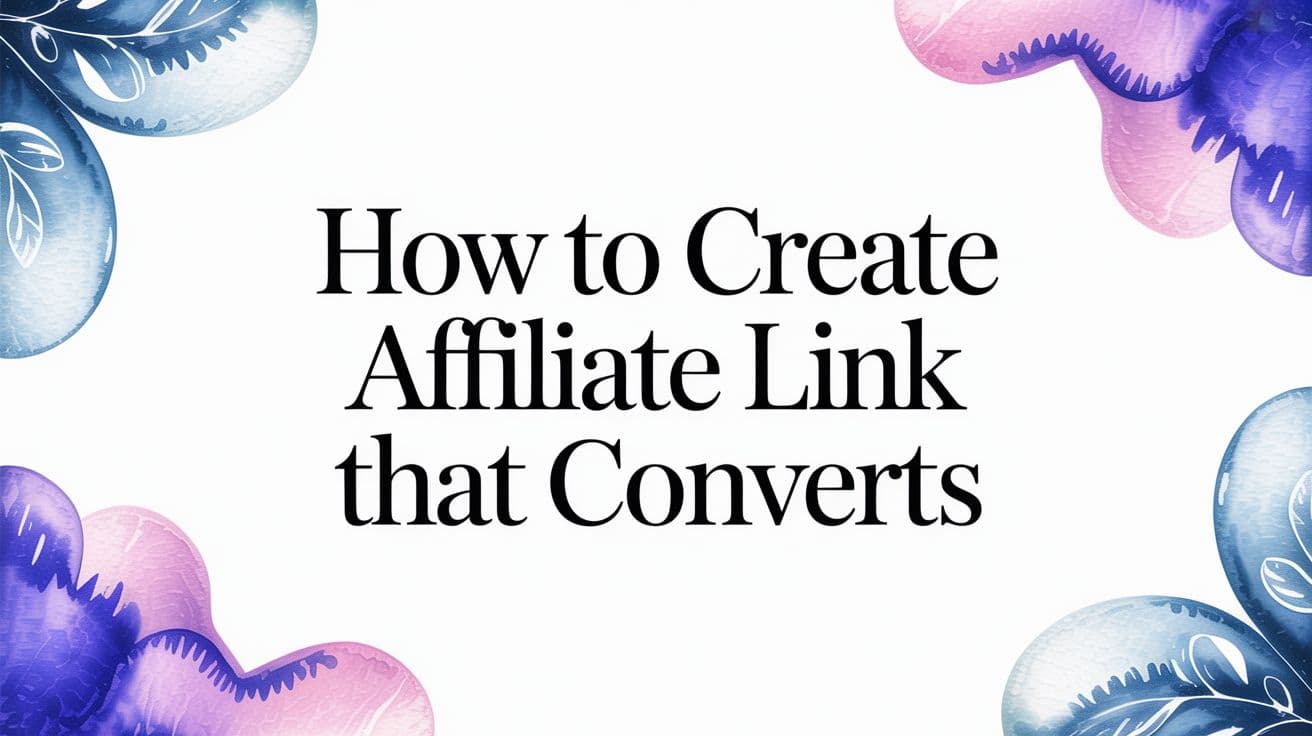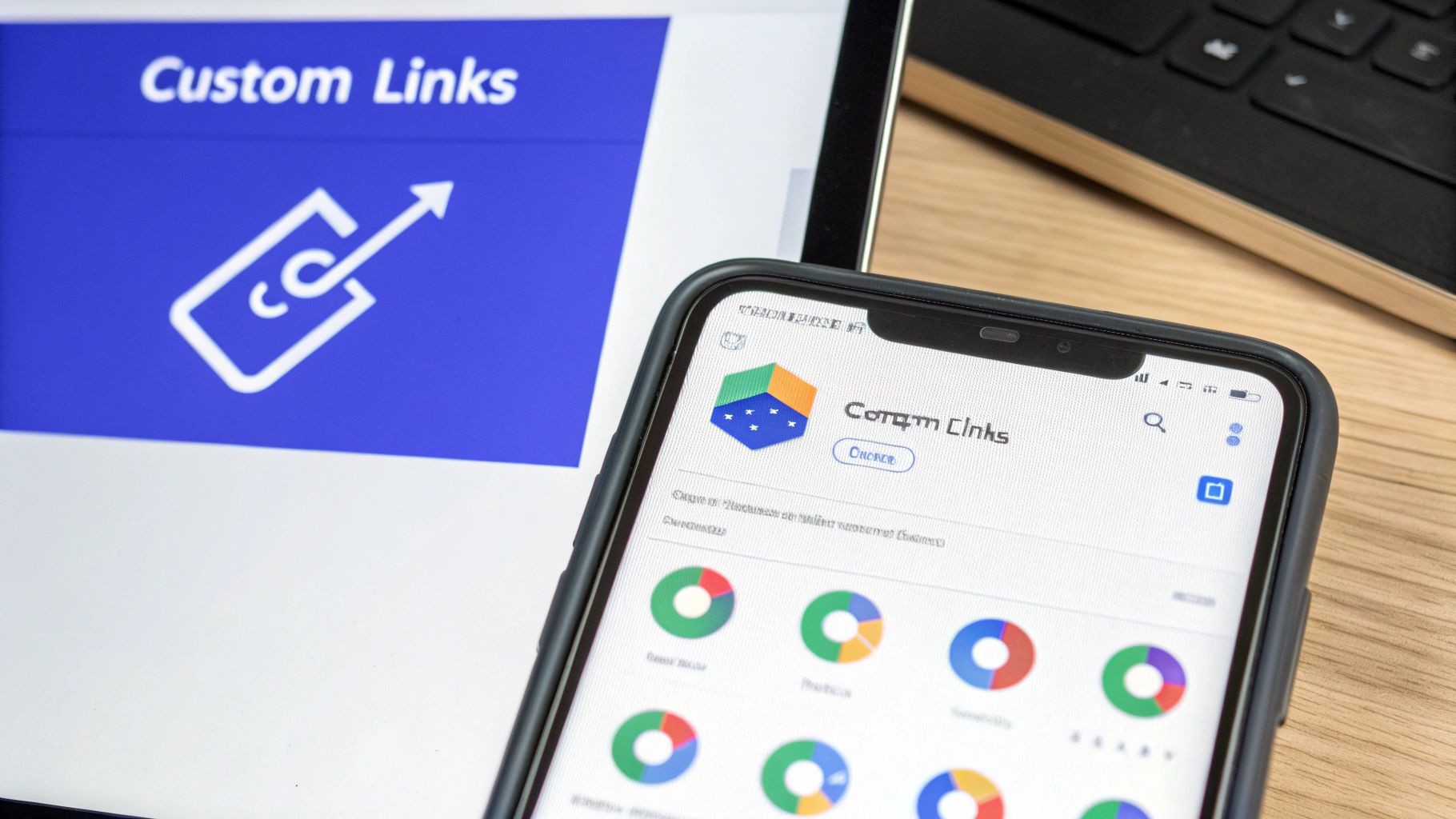how to create affiliate link that converts
how to create affiliate link that converts
Ollie Efez
November 06, 2025•13 min read

At its core, creating an affiliate link is pretty straightforward. You head into your affiliate program's dashboard, find the product you want to promote, and use their tool to generate a unique URL. That link has your special ID baked right in, making sure you get credit for any sales that come from your audience.
Why Getting Your Links Right is a Game-Changer
Before we dive into the nitty-gritty of settings and customization, let's talk about what makes a great affiliate link. It's so much more than just a string of characters; it’s the vital connection between your audience's problem and a solution you genuinely recommend.
A well-made, transparent link doesn't just earn you money—it builds trust. Think of it as the foundation for monetizing your content without feeling salesy.
This classic diagram shows exactly how your link fits into the puzzle, connecting the customer to the merchant through your recommendation.

As you can see, your content—your blog, your YouTube channel, your newsletter—is the crucial "Affiliate" piece that makes the whole system work.
The Massive Opportunity in Affiliate Marketing
In today’s creator economy, knowing how to create and manage your affiliate links is an essential skill. Authentic recommendations are what drive sales now, and this isn't some tiny niche. It's a huge, booming industry.
By 2025, affiliate marketing spending is projected to hit over $10 billion worldwide. Looking further out, the industry's total value is expected to reach an incredible $31.7 billion by 2031.
This isn't just a fleeting trend. Brands are fundamentally changing how they market their products, and they're leaning more and more on trusted voices like yours. With an annual growth rate of around 20%, it's clear that affiliate programs are becoming a standard part of business everywhere.
For small businesses, this is more than just a way to earn commissions; it's a powerful and scalable marketing channel. Folding affiliate strategies into the bigger picture can make a huge difference. For anyone trying to juggle it all, looking into Small Business Marketing Automation is a smart move that can seriously boost your results while saving you precious time.
Finding Affiliate Programs That Fit Your Audience
Knowing how to create an affiliate link that actually makes you money starts way before you ever generate a URL. It really begins with picking the right partners. This is a step where so many creators stumble. If you try to push a product that doesn't genuinely connect with your audience, you're not just wasting your time—you're risking the trust you've built.
Put yourself in your audience's shoes. If you have a blog dedicated to backpacking across Southeast Asia, signing up with a luxury cruise line just doesn't make sense. Your audience is looking for recommendations on durable backpacks, solid travel insurance, or affordable tour companies. That's where you should focus your search.
Digging Deeper Than a Simple Search
Inside the LinkJolt marketplace, you can go far beyond a basic keyword search. A great first move is to filter programs by your specific niche. This instantly weeds out all the irrelevant brands and shows you partners your audience might actually get excited about.
But don't just stop at the niche. Before you even think about applying, you need to look at a couple of key metrics:
- Earnings Per Click (EPC): This number is your best friend. It gives you a quick, at-a-glance idea of what an affiliate earns, on average, every single time someone clicks their link for that program. A high EPC is often a great sign that the product sells well.
- Cookie Duration: This tells you how long you have to earn a commission after someone clicks your link. Longer cookie windows—like 30, 60, or even 90 days—are fantastic because they give your audience plenty of time to think it over before buying, and you still get the credit.
The goal here isn't just to find any program that will approve you. You're looking for a real partner. Seek out companies with solid reputations, great reviews, and products you'd be happy to use yourself. Your authenticity is everything.
If you want to dive deeper into this, our guide on how to find affiliate programs is the perfect next read. It covers more advanced search strategies and helps you identify those high-potential partnerships that others often overlook. Spending a little extra time on this upfront will make all the difference when it comes time to create links that drive real income.
Generating Your First Link in LinkJolt

So, you've found a great partner program. Awesome. Now comes the fun part: creating the actual affiliate link that will start earning you commissions. This is where your strategy turns into something you can actually use. Thankfully, getting this done in the LinkJolt dashboard is quick and easy.
First thing's first, head over to the “Approved Programs” area in your LinkJolt account. You'll see a list of all the brands you've been approved to work with.
Let's say you run a blog about productivity and just got the green light from a top project management software. Your goal isn't just to link to their generic homepage. You want to point your readers to a specific, high-value page, like their "Team Collaboration Features" page. That’s the key to better conversions.
From Page URL to Affiliate Link
Go to that specific product page on the brand's website and copy the full URL. Now, pop back over to your LinkJolt dashboard. Find the right program from your list and look for the link creation tool. It’s usually as simple as pasting the destination URL into a box and hitting "Generate."
In an instant, LinkJolt gives you a brand new, unique URL. This isn't just any old link—it’s now embedded with your personal tracking code. This is exactly how you create an affiliate link that guarantees every click and sale is properly credited back to you.
At its core, that new link contains your unique affiliate ID. Think of it as a digital fingerprint that tells the merchant’s system, “Hey, this person came from [Your Name]'s recommendation.” It’s the magic that makes this whole thing work and ensures you get paid.
Getting this right is crucial. Affiliate marketing drives about 16% of all e-commerce sales worldwide. A well-placed link to a relevant product plugs you directly into a huge market. Some businesses have even reported a 1400% ROI from their affiliate efforts, which shows just how powerful this can be.
If you need to create links on the fly without digging through menus, LinkJolt’s referral link generator is a great tool to bookmark. It makes the process even faster.
With your trackable link in hand, you're ready for the next step: making it your own through customization.
Customizing Links to Build Trust and Track Performance

Let's be honest, a raw affiliate link—that long string of random numbers and letters—can look sketchy. To a potential customer, it screams "spam," which is the last thing you want. That first impression can kill a click before it ever happens.
This is where you get a huge advantage by cleaning up your links. With LinkJolt's customization tools, you can swap that messy URL for something clean, professional, and branded. It’s a small change that makes your content look more polished and strengthens your credibility, often leading to a real bump in your click-through rates.
The Power of SubIDs for Pinpoint Tracking
Customizing isn't just about looking good; it's about getting smart with your data. The key here is using SubIDs. Think of a SubID as a small tag you add to your affiliate link to see exactly where your clicks and conversions are originating.
Let's say you’re promoting a new software tool across different channels. Instead of using the same link everywhere, you create unique ones:
- Your blog review:
yourlink.com/product?subid=blog-review-post - Your YouTube video description:
yourlink.com/product?subid=youtube-video - Your weekly newsletter:
yourlink.com/product?subid=weekly-email
Suddenly, you’re not just creating an affiliate link; you’re turning it into a powerful data-gathering machine. When you log into your LinkJolt dashboard, you won’t just see total sales. You’ll see that the blog post generated 70% of your conversions, while the newsletter brought in 20%. This kind of insight applies to all types of marketing, which is why it's a good idea to create trackable links for detailed analytics for any campaign.
This granular data is what separates successful affiliates from those who are just guessing. It allows you to double down on what works and refine the channels that aren't performing as well.
To show just how big of a difference this makes, here’s a quick comparison of what a potential customer sees and what you get out of each link type.
Default Link vs. Customized Link
As you can see, taking a few extra seconds to customize your links pays off by improving user trust and giving you the data you need to grow.Finally, always remember that transparency is just as important as a clean link. For tips on doing this right, check out our guide with affiliate link disclosure examples.
Where to Place Your Affiliate Links for Maximum Clicks

You’ve got your shiny new LinkJolt link ready to go, but now comes the most important part: where do you actually put it? This is where the real strategy comes in.
Simply blasting your links everywhere won't work. In fact, it's a great way to turn your audience off. The secret is to place your links where they feel like a natural, helpful next step.
Think about the user's journey. A link is most powerful when it pops up right as someone is looking for an answer. Imagine you're writing a review of a new hiking boot. The perfect spot for your affiliate link is right after you mention how its unique sole provides incredible grip on wet rocks. It's the logical conclusion to the point you just made.
This isn't about selling; it's about guiding. When a link feels like a genuine recommendation, it builds trust and gets clicks.
Mastering Contextual Placement
The best affiliate links blend seamlessly into your content. This is what we call contextual placement, and it works because the link is directly relevant to what your audience is already reading, watching, or learning about.
Here are a few of the most effective spots I've found for placing links:
- Inside Blog Posts: Weave links directly into the text. Instead of a bland "click here," use descriptive anchor text. For example, a phrase like "get the exact coffee maker I use every morning" tells the reader exactly what to expect.
- On a Resource Page: A dedicated "My Gear" or "Recommended Tools" page is gold. It acts as a one-stop shop for your audience and becomes a trusted resource they'll return to again and again.
- In Video Descriptions: If you're on YouTube, don't just dump a list of links. Organize them! A simple heading like "Gear Used In This Video:" followed by a clean list makes it incredibly easy for viewers to find what they're looking for.
Here's a pro tip: change your call-to-action from a command to an invitation. Instead of an aggressive "Buy Now!", try something softer like, "See the latest prices and reviews here." This simple shift in tone can make a huge difference in your click-through rates because it feels less like a hard sell and more like a helpful hand-off.
Alright, let's get into the nitty-gritty of what not to do. Making your first affiliate links is exciting, but a few common slip-ups can stop you in your tracks before you even make your first dollar.
The biggest—and most frustrating—mistake I see people make is simply grabbing the wrong URL. It sounds basic, but it happens all the time. You pull a generic link to a product's homepage instead of the unique, trackable link from your LinkJolt dashboard. If your affiliate ID isn't in that URL, you get zero credit for the sale. It's a painful lesson to learn.
Another classic error is pushing products that have nothing to do with your audience. If you run a blog about vegan baking, suddenly promoting a high-end steak knife set is going to confuse and alienate the very people you've worked hard to attract. Stick to what your audience cares about.
Don't Break Your Audience's Trust
Beyond the technical stuff, a lack of transparency can be a real killer. You have to tell people you're using affiliate links. It's not just a good idea; it's a legal requirement from regulators like the FTC. A quick, honest disclosure right at the top of your post or in your video description is all you need.
A lack of transparency is the fastest way to lose your audience's trust. People are happy to support creators they follow, but they hate feeling deceived. Honesty isn't just a policy; it's a core part of a sustainable affiliate strategy.
Finally, be careful with how you shorten or "cloak" your links. Using LinkJolt to make clean, branded links is smart. But using sneaky redirects that hide the true destination can get you in trouble with search engines and damage your SEO.
The goal is always to be helpful and straightforward. By learning how to create an affiliate link the right way and avoiding these common blunders, you’ll build a much stronger foundation for earning real income from day one.
Got Questions About Affiliate Links? Let's Clear Things Up.
As you dive into creating affiliate links, a few questions tend to surface again and again. Getting these sorted out from the get-go will save you a ton of headaches and help you get things moving much faster.
Let’s tackle the big ones I hear all the time.
How Many Followers Do I Actually Need?
This is probably the number one question on everyone's mind. The honest answer? There is no magic number.
Seriously. Most affiliate programs are far more interested in how engaged your audience is and if they're the right fit for the product. A small, dedicated following that trusts your recommendations is often way more valuable than a massive, passive audience.
Does It Cost Money to Create an Affiliate Link?
Worried about upfront costs? Don't be. It costs absolutely nothing to create an affiliate link.
Joining programs and using a platform like LinkJolt to generate your links is completely free. The real investment is the time and effort you pour into creating great content that genuinely helps your audience.
Do I Need a Website to Be an Affiliate Marketer?
This is a huge one, and the short answer is no, but it definitely helps.
A website or blog is an incredible asset for any affiliate marketer—it's your home base. But it's not the only game in town. You can place affiliate links in a ton of other places where your audience already hangs out.
For example, you could share links in:
- YouTube video descriptions: This is perfect if you do product reviews, tutorials, or "what's in my bag" style videos.
- Email newsletters: You have a direct line to your most loyal followers, making it a great place to share products you truly stand behind.
- Social media posts: Some platforms are pickier than others, but places like Pinterest are fantastic for visually sharing affiliate products.
The real key isn’t about having a website, it’s about owning the channel where you connect with your people. Whether that’s your blog, your YouTube channel, or your email list, having a primary platform gives you control and a solid foundation for your affiliate strategy.
At the end of the day, it all comes down to where your audience lives. If you're a food blogger, a website is your kitchen. If you review camera gear, YouTube is your studio. Go where your people are.
Ready to create, customize, and track your affiliate links without the guesswork? LinkJolt gives you all the tools you need to build a successful affiliate program from the ground up. Get started today on linkjolt.io.
Watch Demo (2 min)
Trusted by 100+ SaaS companies
Start Your Affiliate Program Today
Get 30% off your first 3 months with code LINKJOLT30
✓ 3-day free trial
✓ Cancel anytime